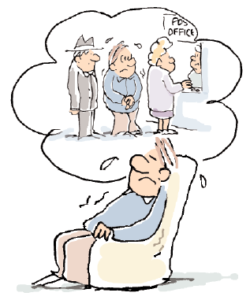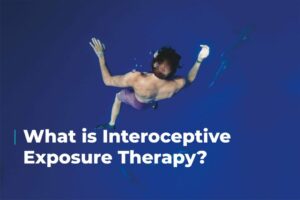Exposure therapy is a type of cognitive-behavioral therapy that has been shown to be effective in the treatment of posttraumatic stress disorder (PTSD). It involves gradually exposing patients to the things that they fear most, in a safe and controlled environment. This can be an extremely effective way to treat PTSD, but it is not always easy for patients to undergo. In this guide, we will discuss exposure therapy in depth, including what it is and how it works. We will also provide tips for those who are considering exposure therapy as a treatment option for PTSD.
Contents
Defining Exposure Therapy For PTSD
 Before understanding how exposure therapy works, it’s important to understand what PTSD is. Post Traumatic Stress Disorder, popular by its acronym PTSD, is a type of anxiety disorder that can develop after someone experiences a traumatic event. This can include events like combat, natural disasters, car accidents, or sexual assault. symptoms of PTSD can include nightmares, flashbacks, panic attacks, and avoidance of anything that might trigger memories of the trauma. For many people, these symptoms can be debilitating and make it difficult to live a normal life.
Before understanding how exposure therapy works, it’s important to understand what PTSD is. Post Traumatic Stress Disorder, popular by its acronym PTSD, is a type of anxiety disorder that can develop after someone experiences a traumatic event. This can include events like combat, natural disasters, car accidents, or sexual assault. symptoms of PTSD can include nightmares, flashbacks, panic attacks, and avoidance of anything that might trigger memories of the trauma. For many people, these symptoms can be debilitating and make it difficult to live a normal life.
While there are many different treatment options for PTSD, exposure therapy has been shown to be one of the most effective.
Exposure therapy is a type of cognitive-behavioral therapy (CBT) that focuses on helping patients confront their fears. The goal is to help patients see that their fears are not as dangerous as they seem, and that they can cope with them. This type of therapy usually involves gradually exposing patients to the things they fear most in a safe and controlled environment. There are many various types of exposures. However, they all share the common goal of helping individuals face their fears.
Types
As stated above, there are various types of exposures under this approach of treatment. Each type has its own unique way of working, but they all aim to increase the patient’s exposure to their feared objects, activities, or situations.
Imaginal exposure
 This involves having the patient imagine the feared situation in detail. The therapist will help the patient to vividly imagine the scene and will encourage them to focus on the sensations and emotions that they feel. It also involves repeatedly doing this until the patient no longer feels anxious about the situation. As the name might suggest, imaginal exposure is based on one’s imagination. It consists of the patient imagining their feared situation in as much detail as possible. The therapist will help the patient to vividly imagine the scene and will encourage them to focus on the sensations and emotions that they feel.
This involves having the patient imagine the feared situation in detail. The therapist will help the patient to vividly imagine the scene and will encourage them to focus on the sensations and emotions that they feel. It also involves repeatedly doing this until the patient no longer feels anxious about the situation. As the name might suggest, imaginal exposure is based on one’s imagination. It consists of the patient imagining their feared situation in as much detail as possible. The therapist will help the patient to vividly imagine the scene and will encourage them to focus on the sensations and emotions that they feel.
For example, if a patient is afraid of flying, the therapist might have them imagine boarding the plane, taking their seat, and going through all the motions of a flight. The therapist would encourage the patient to focus on the sensations they feel, such as the feeling of the seatbelt around their waist or the sound of the plane’s engines.
In vivo exposure
This type of exposure involves confronting the feared situation in real life. This can be done by gradually exposing the patient to the feared object, activity, or situation. The therapist will work with the patient to create a hierarchy of feared situations, starting with the least fearful and working up to the most. This means that patients will gradually work their way up the hierarchy as they become more comfortable with the exposure.
For example, if a patient is afraid of heights, the therapist might start by having them stand on a stool, then progress to standing on a chair, and eventually standing on a ledge. The therapist would help the patient to confront their fear in a safe and controlled environment so that they can learn that the situation is not as dangerous as they thought.
Interoceptive exposure
 This type of exposure focuses on the physical sensations that are associated with anxiety, such as a racing heart or shortness of breath. The goal is to help the patient see that these sensations are not harmful and that they can cope with them. As one might be aware, physical and mental sensations are interconnected. Therefore, by helping patients confront their physical sensations, it can also help to reduce their anxiety about the situation.
This type of exposure focuses on the physical sensations that are associated with anxiety, such as a racing heart or shortness of breath. The goal is to help the patient see that these sensations are not harmful and that they can cope with them. As one might be aware, physical and mental sensations are interconnected. Therefore, by helping patients confront their physical sensations, it can also help to reduce their anxiety about the situation.
For example, if a patient is afraid of closed spaces, the therapist might have them sit in a chair and pump their fists rapidly to increase their heart rate. As their heart rate increases, the therapist would help them to observe and label the physical sensations they are experiencing. The therapist would then help them to understand that these sensations are not harmful and that they can cope with them and further lessen their impact.
Virtual reality exposure therapy
This type of exposure therapy uses computer-generated simulations to exposure the patient to their feared situation. This is a rather new type of exposure therapy that is still being developed. However, there have been promising results with its use in treating PTSD. This therapy works by allowing the patient to control their level of exposure to the feared situation. In other words, they can start off with a less intense version of the simulation and work their way up to a more intense one. For instance, if a client is afraid of flying, they might start by watching a video of an airplane taking off. They would then progress to sitting in a virtual reality simulator of an airplane cabin. As their anxiety decreases, they would eventually be able to fly on a real plane.
This type of exposure therapy has the added benefit of being less expensive and easier to access than in-vivo exposure therapy. In other words, it can be done from the comfort of one’s own home. One study found that 70% of patients who underwent virtual reality exposure therapy no longer met the criteria for PTSD at the end of treatment.
Flooding
 This is a type of exposure therapy that involves having the patient confront their feared situation all at once. The goal of this therapy is to help the patient see that they can cope with the situation and that it is not as dangerous as they thought.
This is a type of exposure therapy that involves having the patient confront their feared situation all at once. The goal of this therapy is to help the patient see that they can cope with the situation and that it is not as dangerous as they thought.
For example, if a patient has issues with flying, they would be asked to fly on an airplane for a long period of time. This may sound like a nightmare for some people, but it has been shown to be very effective in treating PTSD.
One study found that flooding was more effective than gradual exposure therapy in reducing PTSD symptoms. The researchers believe that this is because gradual exposure therapy can often lead to patients feeling more anxious as they anticipate the exposure.
It is important to note that flooding should only be done with the help of a trained therapist. This is not something that you should try on your own.
Prolonged exposure
Lastly, prolonged exposure is a type of exposure therapy that involves facing your fears for an extended period of time. This can be done in sessions with a therapist or on your own. With prolonged exposure, you’ll slowly and gradually face your fears until they no longer bother you. This type of therapy has been shown to be very effective for treating PTSD. For example, if one of your fears is animals, your therapist may start by having you look at pictures of animals. Then, you’ll gradually work your way up to being in the same room as a live animal. Prolonged exposure can be tough, but it’s often worth it for the long-term results.
These are some of the most common types of exposure therapy for PTSD. If you’re considering this type of treatment, be sure to talk to your doctor or therapist about which option would be best for you. Exposure therapy can be an incredibly effective treatment for PTSD, but it’s not right for everyone. However, if you do decide to try exposure therapy, know that you’re not alone—many people have found success with this treatment.
Benefits
The positive effects and benefits of exposure therapy are well-documented. Studies have shown that exposure therapy can be an effective treatment for PTSD, with some studies showing that it can be more effective than other types of treatment, such as cognitive behavioral therapy.
One study found that 83% of patients who underwent exposure therapy no longer met the criteria for PTSD at the end of treatment. That’s an incredibly high success rate, and it shows just how effective this treatment can be.
The benefits of exposure therapy don’t stop there. In addition to reducing PTSD symptoms, exposure therapy has also been shown to reduce anxiety, depression, and stress. It can also help improve sleep and increase self-esteem.
Moreover, it also helps to increase your sense of control and mastery over your fear. After all, the whole point of exposure therapy is to help you confront and overcome your fears.
As you can see, there are many benefits to exposure therapy. If you’re struggling with PTSD or another anxiety disorder, exposure therapy may be a good option for you. Be sure to talk to your doctor or therapist about whether this
Drawbacks
 Exposure therapy is a very effective treatment, but it’s not right for everyone. As with any type of treatment, there are some risks and drawbacks associated with exposure therapy.
Exposure therapy is a very effective treatment, but it’s not right for everyone. As with any type of treatment, there are some risks and drawbacks associated with exposure therapy.
For starters, exposure therapy can be very difficult and uncomfortable. You’ll be facing your fears head-on, which can be tough to do. It’s important to remember, though, that you’ll be doing this with the help of a trained therapist. They will help you through the process and make sure that you’re as comfortable as possible.
Another drawback of exposure therapy is that it can sometimes lead to an increase in anxiety symptoms. This is known as paradoxical fear. Paradoxical fear usually goes away after a few sessions, but it’s still something to be aware of.
Lastly, exposure therapy may not be right for everyone. Some people may not be able to handle the discomfort of facing their fears. Others may not be able to make it to therapy sessions on a regular basis. If you’re considering exposure therapy, be sure to talk to your doctor or therapist about whether it’s right for you.
As you can see, there are some downsides of exposure therapy. However, this does not mean that the treatment is not effective. Exposure therapy is a very effective treatment for PTSD, but it’s not right for everyone. Be sure to talk to your doctor or therapist about whether exposure therapy would be a good option for you.
Things To Consider
If you’re considering exposure therapy, there are a few things you should keep in mind.
- First and foremost, exposure therapy can be intense and may cause you to feel uncomfortable or even trigger your PTSD symptoms. It’s important to work with a qualified therapist who can help you slowly and safely exposure yourself to your triggers.
- Additionally, exposure therapy typically requires multiple sessions in order to be effective. This means that you’ll need to be committed to the process in order to see results.
- Moreover, it is important to find the right therapist who suits your needs and comfort level. Since the procedure can be intense, it is crucial that you work with someone you trust and feel comfortable with.
- Finally, it’s important to remember that exposure therapy is just one tool that can be used to treat PTSD. If you’re not sure if it’s right for you, talk to your doctor or therapist about other options.
No matter what treatment option you choose, remember that you are not alone in your journey to recovery. There are many resources and support groups available to help you cope with your PTSD symptoms.
Alternative Treatments
 If exposure therapy for PTSD is not something you’re interested in, there are other treatment options available. Some of the most popular options include:
If exposure therapy for PTSD is not something you’re interested in, there are other treatment options available. Some of the most popular options include:
- Cognitive behavioral therapy (CBT): CBT is a type of therapy that helps you change the way you think and behave. This can be helpful in treating PTSD by helping you to challenge and change negative thoughts and behaviors.
- Eye movement desensitization and reprocessing (EMDR): EMDR is a type of therapy that uses eye movements to help you process and heal from trauma. This can be helpful in treating PTSD by helping you to process and make peace with your memories.
- Medication: There are several types of medication that can be used to treat PTSD. These include antidepressants, anti-anxiety medications, and antipsychotics. Medication can be helpful in treating PTSD by reducing symptoms and helping you to feel more stable.
- Support groups: There are many support groups available for people with PTSD. This can be helpful in treating PTSD by providing you with a sense of community and support.
As you can see, there are many treatment options available for PTSD. If you’re not sure if exposure therapy is right for you, talk to your doctor or therapist about other options. No matter what treatment option you choose, remember that you are not alone in your journey to recovery. There are many resources available to help you cope with your PTSD symptoms.
Conclusion
In conclusion of the above, exposure therapy is a very effective treatment for PTSD, but it’s not right for everyone. Be sure to talk to your doctor or therapist about whether exposure therapy would be a good option for you. There are many alternative treatments available if exposure therapy is not something you’re interested in. No matter what treatment option you choose, remember that you are not alone. With the right resources and support, you can overcome your PTSD symptoms.
If you or someone you know is looking for psychological help, Therapy Mantra is here for you. We are the leading providers of online therapy and counseling. Our team of highly trained and experienced therapists can provide assistance at the most affordable rates. Contact us today to learn more about our services. You may also visit our website to book an online therapy session or download our free Android or iOS app for more information.


